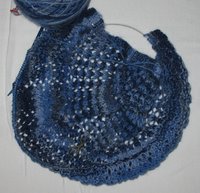A bead post(!)

We had a brief discussion about bead looms recently on a group, and since I'm buried in tax stuff and won't even be going to teen knitting club today, I've imported my response post.
 Also, it's pouring rain, so here's a picture of the cobble stones outside our front door when DD left for the bus, and a cheerful sky snippet above from a few nights ago to remind me that the world is not always dreary.
Also, it's pouring rain, so here's a picture of the cobble stones outside our front door when DD left for the bus, and a cheerful sky snippet above from a few nights ago to remind me that the world is not always dreary.
Suzanne Cooper has a handy set of beadwork links. My favorite vendor is Beki at Out on a Whim, a fun store up in Cotati, California.
I absolutely adore Don Pierce, whom I met at the first Interweave Bead Bash up in Estes Park some years ago. He and his wife are truly good people and his beadwork is art. In person it shimmers and glows with a life of its own, and when a person wears the piece the two merge and the person takes on that extra something that was in the beadwork. He is a wonderful teacher and a fair and honest vendor, too. Walking into a classroom where he is teaching you can feel the magic.
Another expert teacher and hilarious person is Jeannette Cook. Her classroom is an endless party of laughter and "I've got it!" and color and fun. She has tricks and techniques that remove the frustration from beadwork and fill a person with ideas. She is one of those special teachers who makes learning hard things a breeze, and her lessons have that auto-fuse feature where they become part of your mind instead of departing through the other ear. She is great!
If you can get a copy of The New Beadwork by Scherer and Moss you'll see some very inspiring work. Many of those artists went on to write books. Charlene mentioned Valerie Hector. David Dean is another gifted beadworker. I would love to own one of David Dean's pieces... The other person whose beadwork I enjoy very, very much is David Chatt.
Interweave's Beader's Companion is a handy little reference and good to have around. I used to write for their magazine. I never, ever, wrote for Bead & Button, though they asked. They were difficult to work with in the early years (does that sound diplomatic?), while Linda Ligon, Jean Scorgie, and then Jean Campbell over at Interweave were gems of the first order.
Looms. Is it a Mirrix or homebuilt or ??? It makes a big difference. I used custom homebuilts, just rigid frames because that's what suited my designs the best. Mirrix looms are lovely for collars.
1) Loom weaving beadwork is quicker. What I was known for in the trade was 3-D freeform peyote critters, rigid, stand alone, weird colors (hey, I had an orange tumor in my dominant eye), and expressive. I also made a lot of game boards to pay the bills, and while I can work (even without good vision) flat peyote or any other flat stitch REALLY REALLY fast, a loom is quicker. Even running the chicken farm with a new baby, no plumbing, and a wastrel for a husband (the ex), I could weave upwards of 3000 beads per day in an exceptionally complex color pattern. Peyote at full speed, maybe half that per day.
2) Looms yield better drape. Having a long tensioned warp transforms large flat pieces of beadwork from craft to art. There are few things in this world that appeal to my senses as much as cutting a length of glass bead fabric off a loom. I usually worked with Nymo O for warp and weft and laid a supplementary warp of handspun bombyx froghair, then bound the selvages and cut edges in a bombyx ribbon woven on an Alden Amos tape loom.
3) Looms yield a flat fabric (if you tension your warp evenly and use relatively uniform beads). For game boards, this is rather important. Freehand beadwork has a lot of positive characteristics, but "flat" isn't the first one that comes to mind.
One of the drawbacks of a loom is you have warp ends to deal with after cutting. Because of this, I only used a loom for pieces where a ribbon-bound edge could be seen as a nice addition, where there was another, acceptable way to conceal the cut ends, or when the piece was too large to work comfortably freehand (bigger than 4" x 6").
There are intermediate methods, working on a small pin-loom that stretches each row as it's worked freehand, threading a continuous warp between two fine, adjustable bars, etc. By the end of working a piece with one of these compromise methods, I have always thought I was an idiot and should have used the loom! Oh, and the current state of my EZasPi Anniversary shawl, which might just be finished before the next anniversary... KnitPicks merino laceweight is very, very tolerant of being frogged and re-knit over and over and over again. Not the softest hand, but soft enough, and the durability factor is important since this shawl is for DD.
Oh, and the current state of my EZasPi Anniversary shawl, which might just be finished before the next anniversary... KnitPicks merino laceweight is very, very tolerant of being frogged and re-knit over and over and over again. Not the softest hand, but soft enough, and the durability factor is important since this shawl is for DD.



<< Home